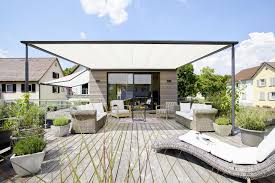When it comes to creating outdoor spaces with shade, pergolas, and awnings stand out as popular choices. Both offer shelter from the sun, but they differ significantly in terms of design, functionality, and aesthetic appeal. In this article, we will delve into the distinctions between pergolas and awnings to help you make an informed decision based on your specific needs and preferences.
Pergolas:
Pergolas are open structures with a framework of vertical posts or pillars that support cross-beams and a durable open lattice. Here are some key features and considerations:
- Aesthetic Appeal: Pergolas are admired for their elegance and timeless charm. The open lattice design allows for the play of light and shadows, creating a visually pleasing and inviting atmosphere.
- Customization: Pergolas offer a high level of customization. You can choose the size, shape, and materials to complement your outdoor space. Additionally, vines or climbing plants can be integrated to add a natural, green element.
- Ventilation: The open structure of a pergola allows for natural ventilation, making it an excellent choice for areas where airflow is crucial.
- Partial Shade: While pergolas provide some shade, they are not completely enclosed. They balance shade and sunlight, making them ideal for those who enjoy a mix of both.
Awnings:
Awnings, on the other hand, are fabric or metal coverings attached to the exterior of a building or freestanding structure. They can be retractable or stationary, and they come in various styles. Consider the following aspects:
- Sun Protection: Awnings are designed primarily for sun protection. They provide a consistent and adjustable shade that can be extended or retracted based on the desired coverage.
- Functionality: Retractable awnings offer flexibility, allowing you to control the amount of shade at different times of the day. This is especially beneficial for outdoor spaces that may need shade during certain hours but not others.
- Weather Resistance: Awnings are effective in providing protection from the sun and light rain. Waterproof materials are often used to ensure durability and functionality during light precipitation.
- Space Efficiency: Awnings are a space-efficient solution, making them suitable for smaller outdoor areas. Their attachment to the building allows for the utilization of available space without the need for additional support structures.
Choosing Between Pergolas and Awnings:
- Consider the Purpose: If you’re looking for an aesthetic focal point with a mix of shade and sunlight, a pergola might be the ideal choice. If consistent and adjustable shade is the priority, an awning might be more suitable.
- Space and Size: Assess the size of your outdoor space. Pergolas are suitable for larger areas, while awnings are space-efficient and adaptable to smaller settings.
- Maintenance: Pergolas generally require less maintenance, while awnings may need regular cleaning, especially if retractable.
- Budget: Consider your budget, as pergolas may involve a higher upfront cost due to customization and construction, while awnings offer a more cost-effective solution.
Conclusion:
Whether you choose a pergola or an awning depends on your specific preferences, needs, and the characteristics of your outdoor space. Both options provide effective shade solutions, but the decision ultimately comes down to the desired aesthetics, functionality, and budget constraints. Evaluate these factors carefully to create the perfect outdoor retreat that suits your lifestyle.

